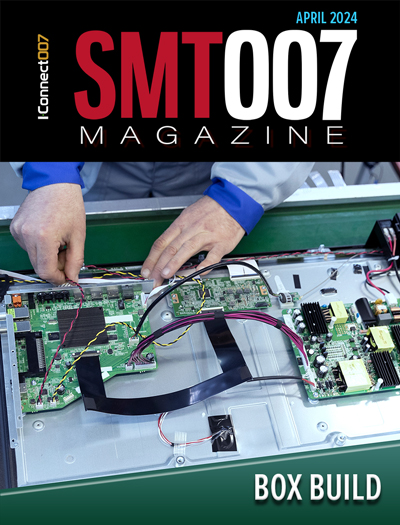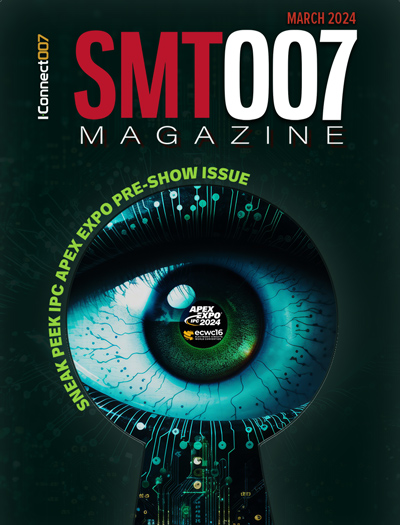-

- News
- Books
Featured Books
- smt007 Magazine
Latest Issues
Current Issue
Box Build
One trend is to add box build and final assembly to your product offering. In this issue, we explore the opportunities and risks of adding system assembly to your service portfolio.

IPC APEX EXPO 2024 Pre-show
This month’s issue devotes its pages to a comprehensive preview of the IPC APEX EXPO 2024 event. Whether your role is technical or business, if you're new-to-the-industry or seasoned veteran, you'll find value throughout this program.

Boost Your Sales
Every part of your business can be evaluated as a process, including your sales funnel. Optimizing your selling process requires a coordinated effort between marketing and sales. In this issue, industry experts in marketing and sales offer their best advice on how to boost your sales efforts.
- Articles
- Columns
Search Console
- Links
- Events
||| MENU - smt007 Magazine
Book Excerpt: 'The Printed Circuit Assembler’s Guide to… Solder Defects'
June 7, 2022 | I-Connect007 Editorial TeamEstimated reading time: 1 minute
The Printed Circuit Assembler’s Guide to… Solder Defects—authored by the experts at Indium Corporation and exclusively available in the I-007eBook library—is specifically dedicated to educating the printed circuit board assembly sector and serves as a valuable resource for people seeking the most relevant information available. What follows is the introduction from this book.
Introduction:
In 2006, much of the world switched from tin-lead to lead-free solder. The European Union’s Restriction of Hazardous Substances (RoHS) directive, which essentially eliminated lead from electrical solder, drove this global move. This change has challenged circuit board assemblers since Pb-free solders melt at temperatures nearly 40°C hotter than lead-containing solders, and they do not flow or wet as well as SnPb solders.
At the same time, the density of electronics has unabatedly increased. This density increase has resulted in exponentially more powerful electronics—the fastest supercomputer of 1996 is outperformed by today’s iPhone 11 Pro—creating another challenge for assemblers. Whereas the 0402 passive was the leading edge in miniaturization in the SnPb era, the 0201, 01005, and smaller passives have emerged for Pb-free soldering. The combined challenges of Pb-free soldering and ever-increasing miniaturization have resulted in new or exacerbated defects in electronics assembly. This book was developed to address this problem, and will address the following defect topics:
- Voiding in SMT Assembly
- Graping
- Head-in-Pillow and Non-Wet Open Defects
- Tombstoning of Passive Components
- Solder Paste Insufficients
- Solder Balling and Beading
It is also important to recognize that effective electronics assembly is an optimization process—often, minimizing one defect will exacerbate another. So, in addition to the information presented here, when confronted with a process defect or challenge, it is helpful to refer to experts from your materials or equipment suppliers. IPC and SMTA standards should provide further guidance as well, along with the many excellent courses presented by these industry organizations.
Suggested Items
Inkjet Solder Mask ‘Has Arrived’
04/10/2024 | Pete Starkey, I-Connect007I was delighted to be invited to attend an interactive webinar entitled “Solder Mask Coating Made Easy with Additive Manufacturing,” hosted by SUSS MicroTec Netherlands in Eindhoven. The webinar was introduced and moderated by André Bodegom, managing director at Adeon Technologies, and the speakers were Mariana Van Dam, senior product manager PCB imaging solutions at AGFA in Belgium; Ashley Steers, sales manager at Electra Polymers in the UK; and Dr. Luca Gautero, product manager at SUSS MicroTec Netherlands.
TE Connectivity Orders Hentec Industries/RPS Automation Pulsar Solderability Testing System
04/09/2024 | Hentec Industries/RPS AutomationHentec Industries/RPS Automation, a leading manufacturer of selective soldering, lead tinning and solderability test equipment, is pleased to announce that TE Connectivity has finalized the purchase of a Pulsar solderability testing system.
Indium to Host Free Webinar on Lead-Free Solder Paste for Automotive Applications
04/09/2024 | Indium CorporationIndium Corporation’s Senior Research Metallurgist, Jie Geng, Ph.D., will conduct a webinar on low-voiding, high-reliability, lead-free solder paste for automotive applications.
AIM Solder Appoints Katherine Blake as Business Development Manager - Automotive
04/04/2024 | AIM SolderAIM Solder, a global leader in solder assembly materials for the electronics industry, is thrilled to announce the appointment of Katherine Blake as the new Business Development Manager - Automotive. Operating from Belgium, Blake's appointment underscores AIM Solder's commitment to enhancing its strategic initiatives worldwide.
MS2 a Beneficial System for Reducing Solder Dross
04/04/2024 | I-Connect007 Editorial TeamWe recently spoke with Octavio Raygoza, sales manager for P.Kay Metal in Mexico, to discuss how P.Kay’s MS2® system for reducing solder dross is both financially and environmentally responsible. By reducing solder dross up to 85%, you nearly double the output while consuming the same amount of solder.


